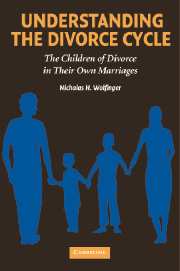Book contents
- Frontmatter
- Contents
- Preface
- Acknowledgments
- 1 Introduction
- 2 Why Divorce Begets Divorce
- 3 Coupling and Uncoupling
- 4 How Strong Is the Divorce Cycle?
- 5 Historical Developments
- 6 The Cohabitation Revolution
- 7 Conclusion
- Appendix A Data and Methods
- Appendix B Evaluating the Role of Marriage Differentials in the Weakening Divorce Cycle
- Notes
- Bibliography
- Index
6 - The Cohabitation Revolution
Published online by Cambridge University Press: 27 July 2009
- Frontmatter
- Contents
- Preface
- Acknowledgments
- 1 Introduction
- 2 Why Divorce Begets Divorce
- 3 Coupling and Uncoupling
- 4 How Strong Is the Divorce Cycle?
- 5 Historical Developments
- 6 The Cohabitation Revolution
- 7 Conclusion
- Appendix A Data and Methods
- Appendix B Evaluating the Role of Marriage Differentials in the Weakening Divorce Cycle
- Notes
- Bibliography
- Index
Summary
If this book had been written thirty years ago, there would be no need for a chapter on cohabitation. Cohabiting couples were far less common and far more stigmatized – we need only remember the quaint phrase “living in sin” to make that point. Living with a partner out of wedlock used to be something only a few unconventional people did.
No longer. Since the 1970s, rates of cohabitation have risen fivefold. Perhaps even more noteworthy, increases in cohabitation almost perfectly correspond with declines in the marriage rate: Living with a partner out of wedlock is becoming a substitute for marriage for more and more people. As I showed in Chapter 3, this holds particularly true for the children of divorce, whose marriage rates have declined even more quickly than those of the general population. It already has been well established that parental divorce increases the likelihood of entering into a cohabiting relationship. Only three studies have considered how the children of divorce fare in cohabiting relationships, however. Two studies by Kathleen Kiernan and her colleagues analyzed married and cohabiting respondents together, a research strategy that does not permit insight into the unique effects of family structure on offspring cohabitation stability. A third study found no relationship between parental divorce and cohabitation dissolution. No studies have examined whether parental divorce affects the likelihood of marrying one's cohabiting partner. These topics are the focus of the current chapter.
- Type
- Chapter
- Information
- Understanding the Divorce CycleThe Children of Divorce in their Own Marriages, pp. 93 - 104Publisher: Cambridge University PressPrint publication year: 2005



